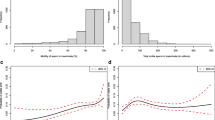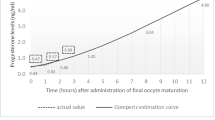Abstract
Research question
Can an optimal LH threshold algorithm accurately predict timing of ovulation for natural cycle–intrauterine insemination (NC-IUI)?
Design
A retrospective cohort study (2018–2022) including 2467 natural cycles. Ovulation timing for these cycles was determined using a previously developed AI model. Two LH thresholds, low and high, were determined in the LH algorithm. Being below the low threshold meant that ovulation is likely to occur in ≥ 4 days, suggesting another daily blood test. Between the two thresholds meant that ovulation was likely in 2–3 days, suggesting IUI the next day. Above the high threshold meant that ovulation will likely occur tomorrow, suggesting performing IUI on the same day.
Results
The optimal LH model with a high threshold of 40 mIU/ml and a low threshold of 11 mIU/ml succeeded in correctly predicting timing for IUI (day − 1, − 2 relative to ovulation) in 75.4% (95%CI 75.3–75.4). In 23.1% (95%CI 23.0–23.2), the algorithm predicted “error,” suggesting performing insemination when in fact it would have been performed on a non-optimal day (0 or − 3). A previously described 3-hormone-based (LH, estradiol, progesterone) AI model performed significantly better in all parameters (93.6% success rate, 4.3 “error” rate).
Conclusions
An LH threshold model, representing common practice, evaluating all possible high and low LH threshold combinations, was successful in accurately scheduling timing for IUI in only 75% of cases. Integrating all three hormones as performed in the AI model may have an advantage in accurately predicting the optimal time for IUI, over the use of LH only.



Similar content being viewed by others
Data availability
The data that support the findings of this study are not openly available due to reasons of sensitivity and are available from the corresponding author upon reasonable request.
References
Blockeel C, Knez J, Polyzos NP, De Vos M, Camus M, Tournaye H. Should an intrauterine insemination with donor semen be performed 1 or 2 days after the spontaneous LH rise? A prospective RCT. Hum Reprod. 2014;29:697–703. https://doi.org/10.1093/HUMREP/DEU022.
Cantineau AEP, Janssen MJ, Cohlen BJ, Allersma T. Synchronised approach for intrauterine insemination in subfertile couples. Cochrane Database Syst Rev. 2014;(12):CD006942. https://doi.org/10.1002/14651858.CD006942.PUB3.
Cohlen B, Bijkerk A, Van Der Poel S, Ombelet W. IUI: review and systematic assessment of the evidence that supports global recommendations. Hum Reprod Update. 2018;24:300–19. https://doi.org/10.1093/humupd/dmx041.
Erden M, Mumusoglu S, Polat M, Ozbek IY, Esteves SC, Humaidan P, Yarali H. The LH surge and ovulation re-visited: a systematic review and meta-analysis and implications for true natural cycle frozen thawed embryo transfer. Hum Reprod Update. 2022;28:717–32. https://doi.org/10.1093/humupd/dmac012.
Testart J, Frydman R, Feinstein MC, Thebault A, Roger M, Scholler R. Interpretation of plasma luteinizing hormone assay for the collection of mature oocytes from women: definition of a luteinizing hormone surge-initiating rise. Fertil Steril. 1981;36:50–4. https://doi.org/10.1016/S0015-0282(16)45617-7.
Wetzels LCG, Hoogland HJ. Relation between ultrasonographic evidence of ovulation and hormonal parameters: luteinizing hormone surge and initial progesterone rise. Fertil Steril. 1982;37:336–41. https://doi.org/10.1016/S0015-0282(16)46092-9.
Bartels CB, Ditrio L, Grow DR, O’Sullivan DM, Benadiva CA, Engmann L, Nulsen JC. The window is wide: flexible timing for vitrified–warmed embryo transfer in natural cycles. Reprod Biomed Online. 2019;39:241–8. https://doi.org/10.1016/J.RBMO.2019.04.003.
Groenewoud ER, Kollen BJ, MacKlon NS, Cohlen BJ. Spontaneous LH surges prior to HCG administration in unstimulated-cycle frozen-thawed embryo transfer do not influence pregnancy rates. Reprod Biomed Online. 2012;24:191–6. https://doi.org/10.1016/J.RBMO.2011.11.003.
Irani M, Robles A, Gunnala V, Reichman D, Rosenwaks Z. Optimal parameters for determining the LH surge in natural cycle frozen-thawed embryo transfers. J Ovarian Res. 2017;10:1–7. https://doi.org/10.1186/S13048-017-0367-7/TABLES/3.
Ursillo L, Peyser A, Abittan B, Mullin C. A novel approach to natural frozen embryo transfers (FET). Fertil Steril. 2021;116:e145. https://doi.org/10.1016/j.fertnstert.2021.07.402.
Youngster M, Luz A, Baum M, Hourvitz R, Reuvenny S, Maman E, Hourvitz A. Artificial intelligence in the service of intra uterine insemination and timed intercourse in spontaneous cycles. Fertil Steril. 2023. https://doi.org/10.1016/j.fertnstert.2023.07.008.
Stanford JB, White GL, Hatasaka H. Timing intercourse to achieve pregnancy: current evidence. Obstet Gynecol. 2002;100:1333–41. https://doi.org/10.1016/S0029-7844(02)02382-7.
Erden M, Polat M, Mumusoglu S, Ozbek IY, Dere GO, Sokmensuer LK, Esteves SC, Humaidan P, Yarali H. Vitrified–warmed blastocyst transfer timing related to LH surge in true natural cycle and its impact on ongoing pregnancy rates. Reprod Biomed Online. 2022;45:440–7. https://doi.org/10.1016/j.rbmo.2022.04.018.
Temporal relationships between ovulation and defined changes in the concentration of plasma estradiol-17 beta, luteinizing hormone, follicle-stimulating hormone, and progesterone. I. Probit analysis. World health organization, task force on methods for the determination of the fertile period, special programme of research, development and research training in human reproduction. Am J Obstet Gynecol. 1980;138(4):383–90.
Manders M, McLindon L, Schulze B, Beckmann MM, Kremer JAM, Farquhar C. Timed intercourse for couples trying to conceive. Cochrane Database Syst Rev. 2015;(3):CD011345. https://doi.org/10.1002/14651858.CD011345.PUB2.
Practice Committee of the American Society for Reproductive Medicine and the Practice Committee of the Society for Reproductive Endocrinology and Infertility. Electronic address: asrm@asrm.org. Optimizing natural fertility: a committee opinion. Fertil Steril. 2022;117(1):53–63. https://doi.org/10.1016/j.fertnstert.2021.10.007.
Nulsen J, Wheeler C, Ausmanas M, Blasco L. Cervical mucus changes in relationship to urinary luteinizing hormone. Fertil Steril. 1987;48:783–6. https://doi.org/10.1016/S0015-0282(16)59530-2.
Khattab AF, Mustafa FA, Taylor PJ. The use of urine LH detection kits to time intrauterine insemination with donor sperm. Hum Reprod. 2005;20:2542–5. https://doi.org/10.1093/humrep/dei098.
Funding
This study was funded by FertilAI, Israel.
Author information
Authors and Affiliations
Contributions
A.H, R.H, A.L, E.M, and M.Y designed the study, A.H, E.M, M.B, R.H, E.M, T.B.B, and A.L contributed to the data collection, M.Y, A.H, A.L, and E.M drafted the first version of the manuscript, A.L, S.R, A.H, R.H, and M.Y contributed to data analysis and interpretation. All authors revised the manuscript and approved the final submitted version.
Corresponding author
Ethics declarations
Conflict of interest
A.H, E.M, R.H, A.L, and M.B are shareholders and board members of FertilAI LTD. S.R and E.M are employees of FertilAI LTD. M.Y and T.B.B report no conflict of interest.
Additional information
Publisher's Note
Springer Nature remains neutral with regard to jurisdictional claims in published maps and institutional affiliations.
Supplementary Information
Below is the link to the electronic supplementary material.
Rights and permissions
Springer Nature or its licensor (e.g. a society or other partner) holds exclusive rights to this article under a publishing agreement with the author(s) or other rightsholder(s); author self-archiving of the accepted manuscript version of this article is solely governed by the terms of such publishing agreement and applicable law.
About this article
Cite this article
Youngster, M., Moran, E., Luz, A. et al. Intrauterine insemination timing models—LH can only take you so far. J Assist Reprod Genet (2024). https://doi.org/10.1007/s10815-024-03135-4
Received:
Accepted:
Published:
DOI: https://doi.org/10.1007/s10815-024-03135-4




